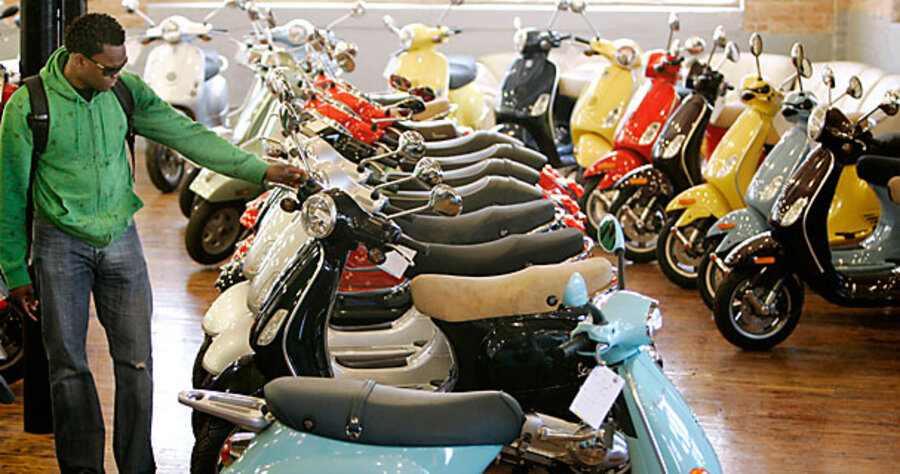Gas prices accelerating scooter sales
Loading...
These days, everyone seems to be talking about scooters. A long article on the Wall Street Journal includes a video of a reporter tooling around New York on a Vespa, in scenes that look right out of "Roman Holiday." At the LA Times, motorcycle blogger Susan Carpenter takes six higher-speed scoots for a spin. Last Thursday, the Associated Press ran a story discussing how high gas prices have prompted a 24 percent jump in scooter sales in the first quarter of this year. Also last week, the Denver Post reported record ridership in the Mile High City. And this publication beat them all to the story, running a piece in March headlined "Easy riders: Scooters on road toward mainstream acceptance."
It's a topic that is dear to me: Last July, fed up with delays on Boston's mass transit and unwilling to drive my car every day, I bought myself a Honda Metropolitan scooter and began using it to commute the four miles from my apartment to the Monitor's offices in downtown Boston. It goes about 40 miles an hour and gets between 80 and 100 miles per gallon (depending on the outside temperature and whether I ride like a maniac).
And yes, I'll be the first to admit that it's dorky, but I've found that I've become much happier after I stopped trying to look cool.
My Met's engine displacement is under 50 cubic centimeters, which means I don't need a motorcycle license to ride it in Massachusetts, just a regular driver's license. It also means that I can legally ride it in the bike lane, which is what I do when traffic is backed up, a great way to draw angry glares from drivers. Parking is never a problem; I can legally leave it on the sidewalk.
Boston's weather isn't exactly the most scooter-friendly, but I managed to make the commute on most days through the winter with a pair of ski pants, warm jacket, and fleece, and, on days when it got below 20 degrees F., a balaclava. When it rains, I wear a rain suit. The only time I don't ride is when there is snow or ice on the ground.
Boston drivers are legendary for their aggression, so those of us on two wheels definitely need to keep our wits about us. On the plus side: I've given up coffee, as I'm wide awake by the time I get to work.
As for protection, I wear a motorcycle helmet and a good pair of gloves. Some scooterists I know go all-out, with motorcycle boots, kneepads and sliders, and armored jackets. But it seems that most of us take our chances with just a helmet.
Did I mention the gas mileage? Every week and a half or so, I put about $2.50 in the tank. Lately, it's been more like $2.70.
From an environmental standpoint, not all scoots are equal. Most older models and some newer ones have a two-stroke engine, like an old-fashioned lawnmower or a chainsaw, which requires a mixture of oil and gas. You can identify these by the puff of blue smoke that belches from their tailpipes as they accelerate. These engines, while generally having a little more zip than their four-stroke counterparts, tend to have terrible emissions. In 2006, the Oregon alt-weekly Willamette Week looked at emissions from two two-stroke scooters and found their exhaust to have far more unburned hydrocarbons and CO2 than an SUV. Granted, SUVs put out a lot more exhaust per mile traveled than a scooter does.
The exhaust from a four-stroke engine, such as the one in my Met, has a much better emissions profile, although it's still not as clean as that which comes from a car's tailpipe, according to the article.
There are more eco-friendly scooters just around the corner. AutoblogGreen has details on a three-wheeled gas-electric hybrid scooter made by Piaggio, the makers of Vespas. And last October, the Monitor's Clay Collins test-drove the all-electric Vectrix, which is now available at some dealers in the US.
Update: US News eco-blogger Maura Judkis compares emissions from two-stroke scooter engines to those from SUVs, using data from Cecil Adams's invaluable Straight Dope column on the subject. Ms. Judkis makes an important distinction between climate change pollution and old-fashioned air pollution. The result? Two-strokes are better for the climate, but worse for city air.
Her blog post gives a somewhat misleading impression about scooters in general though, because it discusses only two-stroke engines, even though she includes a picture of a lineup of Honda Mets, which have four-stroke engines (and catalytic converters to boot). Four-stroke is becoming the norm for most new scooters in the US these days: Check out Vespa's site, and you'll see that they no longer offer any two-strokes.





